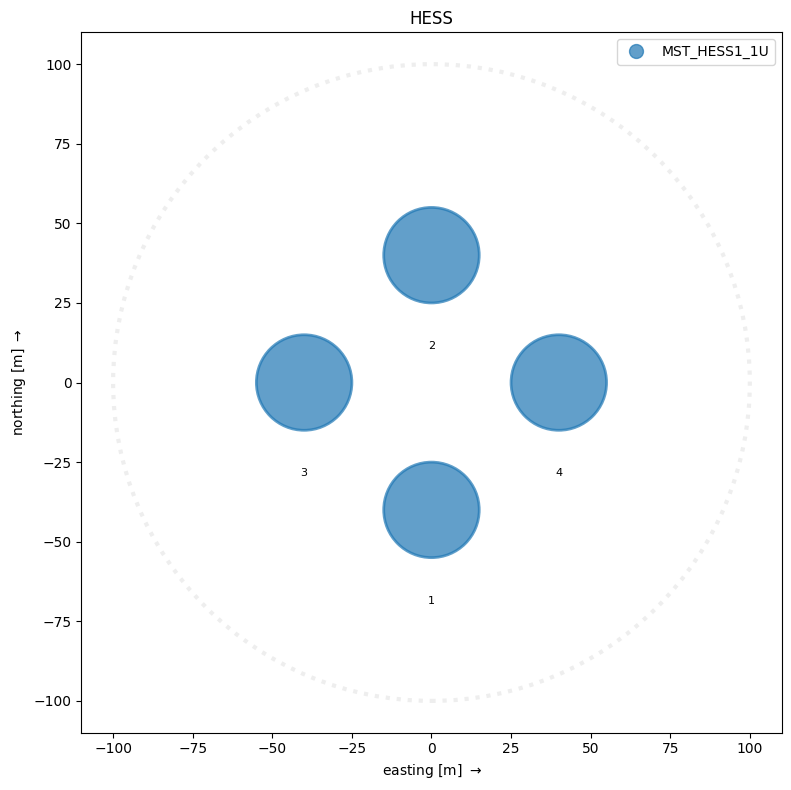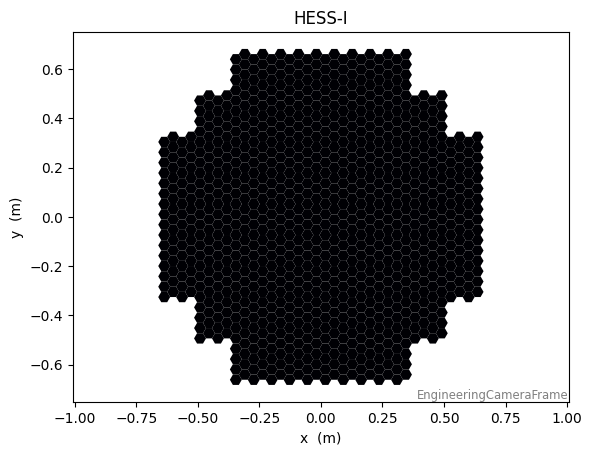Developer Tutorial#
TIP: add the following to the top of your notebook or ipython script to have it automatically reload the imports as you make changes. That makes it much nicer to develop at the same time as working in the notebook:
%load_ext autoreload
%autoreload 2
Using the EventSource interactively.#
Note that you can find detailed tutorials about working with events and EventSources in general in the ctapipe documentation.
The purpose of the HESSEventSource is too make HESS data work with the ctapipe-process command-line tool. Howwever, during development instead of running the tool, it’s often nice to make a small test script to help explore the functionality of the HESSEventSource interactively, either in a python REPL like ipython, or in a Jupyter Notebook.
A basic test is as follows:
[1]:
%matplotlib inline
from ctapipe.coordinates import EngineeringCameraFrame
from ctapipe.io import EventSource
from ctapipe.utils import get_dataset_path
from ctapipe.visualization import CameraDisplay
# load the test file. Note you can substitute your own local filename here instead
# , e.g. filename="my_local_dst_file.root"
FILENAME = get_dataset_path("example_hess_dst.root")
# now just load the first event in the file:
with EventSource(FILENAME, max_events=1) as source:
for event in source:
print(event.index)
/opt/hostedtoolcache/Python/3.13.5/x64/lib/python3.13/site-packages/ctapipe/instrument/camera/geometry.py:616: FromNameWarning: .from_name uses pre-defined data that is likely different from the data being analyzed. Access instrument information via the SubarrayDescription instead.
warn_from_name()
{'event_id': np.int64(13572096655360), 'obs_id': np.int32(170720)}
Now event is the first loaded event, and source will be an instance of HESSIOEventSource, if everything worked correctly
[2]:
source
[2]:
EventSource for HESS DSTs.
| allowed_tels | None | list of allowed tel_ids, others will be ignored. If None, all telescopes in the input stream will be included (default: None) |
|---|---|---|
| input_url | / |
Path to the input file containing events. (default: traitlets.Undefined) |
| max_events | 1 | Maximum number of events that will be read from the file (default: None) |
Look at attributes of the event source and see if they make sense:#
[3]:
source.obs_ids
[3]:
[np.uint64(170720)]
[4]:
for obs_id, ob in source.observation_blocks.items():
print(ob)
ob
{'actual_duration': <Quantity 1872. s>,
'actual_start_time': <Time object: scale='tai' format='mjd' value=0.0>,
'obs_id': np.uint64(170720),
'producer_id': 'HESS',
'sb_id': np.uint64(170720),
'scheduled_duration': <Quantity nan min>,
'scheduled_start_time': <Time object: scale='tai' format='mjd' value=0.0>,
'state': <ObservationBlockState.UNKNOWN: -1>,
'subarray_pointing_frame': <CoordinateFrameType.UNKNOWN: -1>,
'subarray_pointing_lat': <Quantity nan deg>,
'subarray_pointing_lon': <Quantity nan deg>}
[4]:
ctapipe.containers.ObservationBlockContainer:
obs_id: Observation Block ID with default
18446744073709551615
sb_id: ID of the parent SchedulingBlock with default
18446744073709551615 with type <class
'numpy.uint64'>
producer_id: Origin of the obs_id, i.e. name of the telescope
site or 'simulation' with default unknown with
type <class 'str'>
state: State of this OB with default
ObservationBlockState.UNKNOWN with type <enum
'ObservationBlockState'>
subarray_pointing_lat: latitude of the nominal center coordinate of
this observation with default nan deg [deg]
subarray_pointing_lon: longitude of the nominal center coordinate of
this observation with default nan deg [deg]
subarray_pointing_frame: Frame in which the subarray_target is non-
moving. If the frame is ALTAZ, the meaning of
(lon,lat) is (azimuth, altitude) while for ICRS
it is (right-ascension, declination) with
default CoordinateFrameType.UNKNOWN with type
<enum 'CoordinateFrameType'>
scheduled_duration: expected duration from scheduler with default
nan min [min]
scheduled_start_time: expected start time from scheduler with default
0.0
actual_start_time: true start time with default 0.0
actual_duration: true duration with default nan min [min]
[5]:
source.atmosphere_density_profile
[6]:
source.metadata
[6]:
{'is_simulation': False}
[7]:
source.subarray
[7]:
SubarrayDescription(name='HESS', n_tels=4)
[8]:
source.subarray.info()
Subarray : HESS
Num Tels : 4
Footprint: 0.01 km2
Height : 1800.00 m
Lon/Lat : 16.5051989 deg, -23.2771843 deg
Type Count Tel IDs
------------ ----- -------
MST_HESS1_1U 4 1-4
[9]:
source.subarray.peek()
[9]:
<ctapipe.visualization.mpl_array.ArrayDisplay at 0x7f36ca8d2e40>

Look at the images#
first let’s see what telescopes have data in this event:
[10]:
event.dl1.tel.keys()
[10]:
dict_keys([1, 2, 3, 4])
Ok, then we can look at tel_id=1 (which is “CT1”)
The repr of a Container class gives you its contents:
[11]:
event.dl1.tel[1]
[11]:
ctapipe.containers.DL1CameraContainer:
image: Numpy array of camera image, after waveform
extraction.Shape: (n_pixel) if n_channels is 1
or data is gain selectedelse: (n_channels,
n_pixel) with default None
peak_time: Numpy array containing position of the peak of
the pulse as determined by the extractor.Shape:
(n_pixel) if n_channels is 1 or data is gain
selectedelse: (n_channels, n_pixel) with default
None
image_mask: Boolean numpy array where True means the pixel
has passed cleaning. Shape: (n_pixel, ) with
default None as a 1-D array with dtype bool
is_valid: True if image extraction succeeded, False if
failed or in the case of TwoPass methods, that
the first pass only was returned. with default
False
parameters: Image parameters with default None with type
<class
'ctapipe.containers.ImageParametersContainer'>
So, then you can look at elements:
[12]:
event.dl1.tel[1].image.sum()
[12]:
np.float32(0.0)
Display an image to see if things look ok:#
[13]:
tel_id = 1
image = event.dl1.tel[tel_id].image
# best to get the geometry and transform
# it to the EngineeringCameraFrame, which is what you would see if
# looking at the front of the camera
geometry = source.subarray.tel[1].camera.geometry.transform_to(EngineeringCameraFrame())
disp = CameraDisplay(geometry, image=image)

[ ]:
[ ]: